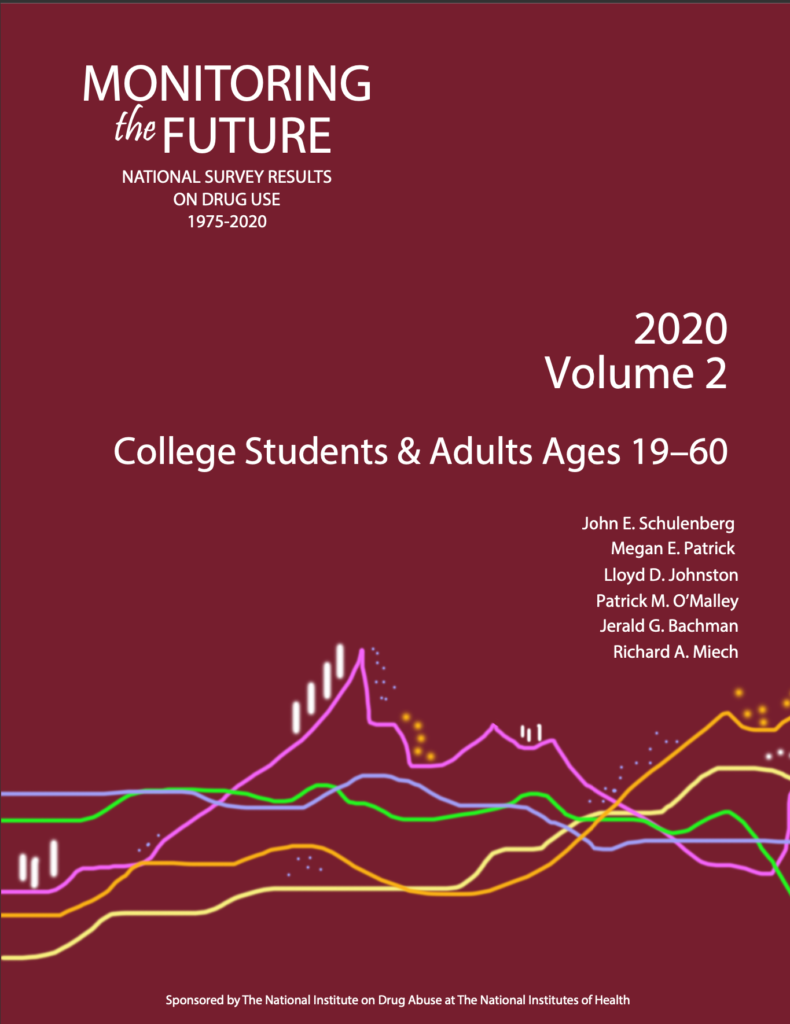The MTF study has tracked and reported on the use of an ever-growing array of legal and illegal substances among U.S. national samples of adolescents and adults for over four decades. The study began with the 12th grade class of 1976. Since then, it has continued to follow-up representative sub-samples of respondents from each previously participating 12th grade class. These follow-up surveys now continue well into adulthood, currently up to age 60. One of the sub-groups examined in the study are college students.
The data for the 2020 report was collected from March to November, 2020 reflecting pandemic effects on substance use as well.
Falling risk perception, rising marijuana use
Key MTF findings on college students’ marijuana use in 2020 and recent trends are:
- In 2020, annual prevalence of marijuana use reached a historic high since the early 1980s, at 44%.
- The five year trend from 2015 to 2020 showed a significant 6% jump in the annual prevalence of marijuana use.
- Daily marijuana use increased to 7.9% a new all-time high over the past four decades.
- Over one-in-twelve college students use marijuana on a daily or near daily basis.
- 30 day marijuana vaping doubled between 2017 to 2019 from 5.2% to 14%. It slightly declined in 2020 to 12%.
The rise in marijuana use among college students is a worrying trend.
Perceived risk plays an important role when it comes to substance use. As per the MTF report, perceived risk for marijuana use among young adults (20 to 30 years) has been greatly decreasing in recent years. In 2020, perceived risk of marijuana use reached all-time lows among young adults for experimental, occasional, and regular use of marijuana. Only 5 to 8% of young adults believed great risk of harm for experimental use of marijuana, and 19 to 22% perceived great risk of regular use.
This means about 9 in 10 young adults do not think experimenting with marijuana has a great risk and about 4 in 5 young adults do not think daily marijuana use is a serious risk.
The lack of awareness about harms caused by marijuana products needs to be addressed urgently since there is mounting evidence of the harm caused by this substance. The addiction risk of marijuana for 12 to 17 year old teens is 10.7%. For 18 to 25 year olds marijuana’s addiction risk is 6.5%.
Declining alcohol use driven by COVID-19 related reductions in availability
Comparatively alcohol use reduced among college students in 2020.
- 30 day alcohol use dropped significantly between 2019 and 2020 from 62.4% to 56%.
- Binge alcohol use dropped to a historic low over the past four decades to 24% in 2020.
The researchers attribute the reductions in alcohol use among college students to pandemic effects. Past 30 day alcohol use remained level for college students between 2015 to 2019 and only changed in 2020.
Comparing to non-college youth of the same age further illustrates this. Non-college youth past 30 day alcohol use did not change much in 2020. While college students have historically had higher binge alcohol use levels, in 2020 for the first time non-college youth reached similar levels since college students binge alcohol use levels dropped.
The data demonstrate the strong alcohol norm in colleges which drive higher alcohol use and binge use.
We clearly see that young people use alcohol as something to be taken at parties and gatherings,” said Professor John Schulenberg, MTF 2020 principal investigator from the University of Michigan, as per The Hill.
With the pandemic, those weren’t happening, so the alcohol intake and binge [alcohol use] dropped.”
Professor John Schulenberg, MTF 2020 principal investigator, University of Michigan

